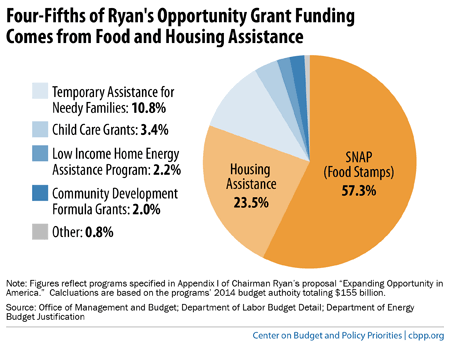BEYOND THE NUMBERS
Ryan’s “Opportunity Grant” Would Likely Force Cuts in Food and Housing Assistance
House Budget Committee Chairman Paul Ryan maintains that consolidating 11 safety-net and related programs into a single “Opportunity Grant” would give states the flexibility to provide specialized services to low-income people. But providing these additional services would require cutting assistance funded through the Opportunity Grant to other needy people. And because SNAP (formerly food stamps) and housing assistance together make up more than 80 percent of the Opportunity Grant, the cuts would almost certainly reduce families’ access to these programs, which are effective at reducing poverty — particularly deep poverty.

SNAP is an entitlement, which means that anyone who qualifies under program rules can receive benefits, and is heavily focused on the poor. Over 91 percent of SNAP benefits go to households with incomes below the poverty line, and 55 percent goes to households in deep poverty — that is, households with cash incomes below half of the poverty line (about $9,800 for a family of three in 2013).
As a result, SNAP kept 4.9 million people out of poverty in 2012, including 2.2 million children. It also lifted 1.4 million children out of deep poverty, more than any other benefit program.
Similarly, housing vouchers and other rental assistance lifted 2.8 million people — including 1 million children — out of poverty in 2012.
Chairman Ryan’s proposal to add new work requirements and provide individualized services to recipients of Opportunity Grant-funded assistance would surely require new staff and significantly raise administrative costs. States would likely turn to SNAP for at least some offsetting savings: it alone makes up more than half of the resources in the Opportunity Grant, and the Ryan proposal ends SNAP as an entitlement, eliminating eligible families’ guarantee to food assistance. Rental assistance, which makes up nearly a quarter of the Opportunity Grant, is another likely target of cuts — though even today it serves only one in four eligible low-income families due to limited funding.
Whatever merit Chairman Ryan’s proposal for personalized services has, his Opportunity Grant could not possibly reach as many families as these existing programs serve.
Cutting food and housing assistance that lifts millions of people out of poverty and is effective at reducing hunger and homelessness in order to provide additional services to a smaller number of poor households isn’t a sound way to reduce poverty.
